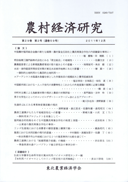Volume 36, Issue 2
JOURNAL OF RURAL SOCIETY AND ECONOMICS
Displaying 1-11 of 11 articles from this issue
- |<
- <
- 1
- >
- >|
Cover
-
2019Volume 36Issue 2 Pages 0
Published: February 01, 2019
Released on J-STAGE: September 01, 2021
Download PDF (337K)
Articles
-
Article type: research-article
2019Volume 36Issue 2 Pages 1-8
Published: February 01, 2019
Released on J-STAGE: September 01, 2021
Download PDF (544K) -
Article type: research-article
2019Volume 36Issue 2 Pages 9-20
Published: February 01, 2019
Released on J-STAGE: September 01, 2021
Download PDF (830K) -
Article type: research-article
2019Volume 36Issue 2 Pages 21-30
Published: February 01, 2019
Released on J-STAGE: September 01, 2021
Download PDF (411K) -
Article type: research-article
2019Volume 36Issue 2 Pages 31-40
Published: February 01, 2019
Released on J-STAGE: September 01, 2021
Download PDF (944K) -
Article type: research-article
2019Volume 36Issue 2 Pages 41-52
Published: February 01, 2019
Released on J-STAGE: September 01, 2021
Download PDF (739K) -
Article type: research-article
2019Volume 36Issue 2 Pages 53-63
Published: February 01, 2019
Released on J-STAGE: September 01, 2021
Download PDF (541K) -
Article type: research-article
2019Volume 36Issue 2 Pages 64-72
Published: February 01, 2019
Released on J-STAGE: September 01, 2021
Download PDF (596K) -
Article type: research-article
2019Volume 36Issue 2 Pages 73-80
Published: February 01, 2019
Released on J-STAGE: September 01, 2021
Download PDF (286K)
Book Review
-
Article type: book-review
2019Volume 36Issue 2 Pages 81-82
Published: February 01, 2019
Released on J-STAGE: September 01, 2021
Download PDF (380K)
Cover
-
2019Volume 36Issue 2 Pages 83-84
Published: February 01, 2019
Released on J-STAGE: September 01, 2021
Download PDF (593K)
- |<
- <
- 1
- >
- >|
